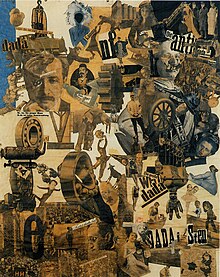Dada (pron.: /ˈdɑːdɑː/) or Dadaism was an art movement of the European avant-garde in the early 20th century. It began in Zurich, Switzerland in 1916, spreading to Berlin shortly thereafter.[1] To quote Dona Budd's The Language of Art Knowledge,
Dada was born out of negative reaction to the horrors of World War I. This international movement was begun by a group of artists and poets associated with the Cabaret Voltaire in Zurich. Dada rejected reason and logic, prizing nonsense, irrationality and intuition. The origin of the name Dada is unclear; some believe that it is a nonsensical word. Others maintain that it originates from the Romanian artists Tristan Tzara and Marcel Janco's frequent use of the words da, da, meaning yes, yes in the Romanian language. Another theory says that the name "Dada" came during a meeting of the group when a paper knife stuck into a French-German dictionary happened to point to 'dada', a French word for 'hobbyhorse'.[2]
The movement primarily involved visual arts, literature, poetry, art manifestoes, art theory, theatre, andgraphic design, and concentrated its anti-war politics through a rejection of the prevailing standards inart through anti-art cultural works. In addition to being anti-war, Dada was also anti-bourgeois and had political affinities with the radical left.
Hannah Höch, Cut with the Dada Kitchen Knife through the Last Weimar Beer-Belly Cultural Epoch in Germany, 1919, collage of pasted papers, 90x144 cm, Nationalgalerie, Staatliche Museen zu Berlin
This week students are creating their own Dada-style collages.

No comments:
Post a Comment